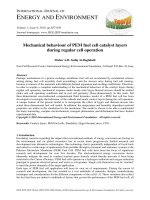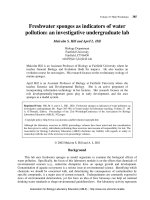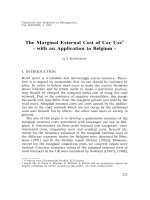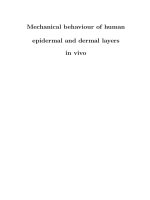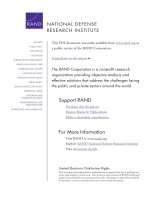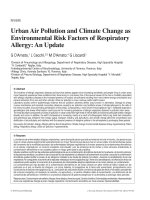Fuel choice behaviour of tribal households: an exploratory analysis
Bạn đang xem bản rút gọn của tài liệu. Xem và tải ngay bản đầy đủ của tài liệu tại đây (373.58 KB, 6 trang )
International Journal of Management (IJM)
Volume 11, Issue 2, February 2020, pp. 175–180, Article ID: IJM_11_02_019
Available online at />Journal Impact Factor (2020): 10.1471 (Calculated by GISI) www.jifactor.com
ISSN Print: 0976-6502 and ISSN Online: 0976-6510
© IAEME Publication
Scopus Indexed
FUEL CHOICE BEHAVIOUR OF TRIBAL
HOUSEHOLDS: AN EXPLORATORY ANALYSIS
Rabinjyoti Khataniar
B.H.College, Howly, Assam, India
Shahnaaz Benazir
Cotton University, Guwahati, Assam, India
Durba Dutta
The Assam Royal Global University, Assam, India
ABSTRACT
Households’ fuel choice behaviour for cooking and heating depends upon number
of socio-economic and demographic factors. The multinomial logistic analysis
expresses choice between three mutually exclusive and differentiated fuels for cooking
and heating. The likelihood ratio tests identifies variables like income of the
household, education level (measured in terms of schooling year attended by the
household members), price of modern fuel, etc. as significant variables in determining
households’ fuel choice behaviour. The study recommend that policy initiative should
attempt at improving livelihood, subsidized LPG distribution policy, increasing the
education level of the household members in tribal household and to create awareness
about the environmental cost and health hazard of biomass fuel consumption in order
to motivate the people towards the modern fuels.
Keywords: Firewood consumption; Fuel choice; Modern fuel; Fuel substitution;
MNL; Health hazard.
Cite this Article: Rabinjyoti Khataniar, Shahnaaz Benazir and Durba Dutta, Fuel
Choice Behaviour of Tribal Households: An Exploratory Analysis. International
Journal of Management (IJM), 11 (2), 2020, pp. 175–180.
/>
1. INTRODUCTION
The behaviour of fuel choice in the household sector is a complex phenomenon determined by
numbers of socio-economic and demographic factors, like family size, living standard,
economic status of the household, urbanization, type of residence, age of the occupants, and
literacy level, etc (Nnaji C. E., Uzoma C. C., Chukwu J. O., 2010). The socio-economic
status of household which increases the frequency of cooking and backing and family size is
the most significant factors influencing amount of firewood consumption in the household
/>
175
Rabinjyoti Khataniar, Shahnaaz Benazir and Durba Dutta
sector (Kebede, A., at al., 2015).The households with higher size are more likely to use
kerosene and firewood. The age of household head also has significant effect on the fuel
choice ( Deshmukh, S., A. Jinturkar and K. Anwar, 2014).
The livelihood of tribal people of Northeast is very much related to the nature. (Nongbri,
T, 1997). Forest is the main source of fuel and fodder for the tribals. On the otherhand,
modern sources of fuels are still out of reach for most of the rural tribal households of the
Northeastern region. Reasons can be attributed to low purchasing power, small requirement,
non- availability etc. As a result firewood has excessive application as fuel in villages as
contrast to kerosene, electricity and natural gas (LPG) in towns and cities (Nanda, A. K. and
S. Khurana, 1995). Researchers identify excessive consumption of firewood as one of the
primary cause of deforestation around. Bio-fuels consumption also has serious health impact
in the form of respiratory diseases, eye diseases, bronchitis, pulmonary tuberculosis, chest
infection etc. (Laxmi, V., J. Parikh, S. Karmakar and P. Dabrase , 2003). Energy substitution,
though on the rise, is still insignificant in rural households of Northeast. However till date, no
systematic study has been conducted in the region to address the factors that determines
household’s fuel choice behaviour. The present study is an attempt in to fill the gap in
knowledge. The main objective of the study is to identify the factors that determine the choice
of a particular type of fuel by the tribal households.
2. MATERIALS AND METHODS
2.1. Description of Study Area
The study area of the research comprises of three Northeastern states namely Arunachal
Pradesh, Assam and Nagaland. The states were selected purposively. Arunachal Pradesh and
Nagaland states were selected as the nearly all the households use firewood for cooking and
heating purposes. However it expected that there exist different types of rules and norms in
extraction of forest product and hence different level of resource availability and degradation.
Assam is relatively a forest scare states amongst the state of Northeastern region. The state
is selected to see how people response to firewood scarcity.
2.2. Sampling Procedure
A multi-stage sampling technique was used for selection of households of the selected
villages. In the first stage three states were selected purposively. In the second stage, two
districts from each state were selected purposively. The districts were selected to represent
different community and different altitude. At stage III, some tribal households dominated
villages were selected from each district randomly. There is a rural urban dichotomy in the
nature of energy consumption due to access rule, availability constraint, demand and supply
conditions, etc. Taking into consideration of this dichotomy, our samples were collected both
from the rural as well as urban areas. Altogether two semi-urban town and 17th number of
tribal villages were selected for ultimate sampling.
It is assumed that villages nearer to the urban centers have a choice in favour of
commercial energy whereas in the interior villages bio-mass fuels are predominantly used for
cooking and other purposes.
In the next stage, altogether 361 sample households were selected by a stratified random
sampling technique of which 77 households were selected from the districts of Assam, 134
households were selected from the districts of Nagaland and 150 numbers of households were
selected from the districts of Arunachal Pradesh. Once villages were selected, the primary
data was collected from the household using a semi-structured schedule.
/>
176
Fuel Choice Behaviour of Tribal Households: An Exploratory Analysis.
2.3. Analytical Methods
To capture the significant variables that believed to influence a household’s choice of cooking
and heating fuel in rural tribal households, a Multinomial Logistic (MNL) Model is adopted.
In the context of surveyed area of Northeast the households were observed using three
different types of fuels for cooking and heating purposes. These are firewood and chips,
firewood with LPG as supplementary, and only LPG. Thus, the model expresses choice
between three mutually exclusive and differentiated fuels cooking and heating.
Evidence that has been gathered in many countries does not support the notion that a
transition from wood-based energy to fuels such as LPG follows any regularised pattern.
Decisions related to energy consumption and fuel type are strongly influenced by
accessibility, affordability and the convenience of the fuel. These criteria are closely related to
one other and also depend on household income. The decision-making process is complex
with economic and technical aspects interlinked with social and cultural issues (see Table
1.1). Cooking with wood fuels, for instance, is so deeply ingrained in many local cultures that
other fuels have little appeal, even when the potential health and environmental benefits are
recognised by users. Furthermore, the prevalence of wood fuel in many developing countries
can be explained by the fact that it is still the most readily available, affordable or even costfree cooking and heating fuel.
2.4. The Model
The model started with an individual utility function which selects a particular fuel type for
maximizing its expected utility. Thus the ith individual’s expected utility takes the form:
Where, i= 1, 2, ......361
Let ϒ be the dependent variable, the fuel choice for cooking and heating with firewood as
reference group. Let Pr (Yi=j) be the probability of choosing fuel-type for cooking and
heating. j is the number of fuel in the choice set (j=1,2,3) and j=1 for reference fuel firewood.
Let
be the vector of predictors and
is a vector of estimated parameters. Thus the
household’s fuel choice behavior can be presented as
=∑
j= 1, 2, 3.
The random distribution terms are independently and identically distributed and odds of
choosing an alternative fuel remain unaffected. The probability of choosing a type of fuel
does not change respective to one alternative or more.
Is the vector of individual characteristics It includes all the variables such as
household, economical, demographic and geographical which may affect household’s fuel
choice behaviour for cooking and heating.
3. RESULTS AND DISCUSSION
The descriptive statistics of the predictors in terms of mean, standard deviation, minimum and
maximum values were calculated to check the existence of outlier in such values of the
variable, if any. The likelihood ratio chi-square estimated at 223.74 with a p-value < 0.01 tells
us that our model as a whole fits significantly better than an empty model (i.e., a model with
no predictors).
The likelihood ratio tests are presented in the table-I. The significant variable can be
identified depending upon p-value. If it is less than .05, then that variable has a significant
overall effect on the outcome. If it is more than .05, then that variable does not have a
/>
177
Rabinjyoti Khataniar, Shahnaaz Benazir and Durba Dutta
significant overall association with the outcome. Accordingly, variables income of the
household, education level (measured in terms of schooling year attended by the household
members), price of modern fuel are found significant in determining households’ fuel choice
behaviour.
Table 1: Likelihood Ratio Tests
Model Fitting Criteria
Likelihood Ratio Tests
Effect
-2 Log Likelihood of
Reduced Model
Chi-Square
df
Sig.
Intercept
315.387
9.386
2
.009
FSIZE
307.054
1.053
2
.591
PRICE_LPG
326.615
20.614
2
.000
AGEHH
310.800
4.799
2
.091
SCH_YEAR
331.940
25.939
2
.001
INCOME
385.483
79.482
2
.001
Note: FSIZE = Family size; PRICE_LPG: Price of LPG; AGEHH: Age of head of the
household; SCH_YEAR: Average year of schooling of the household members;
INCOME: Household income (Rs./capita/month
Source: Self calculated by the author based on field survey data.
Table-II gives the estimates of β coefficient of the multinomial logit model, their level of
significance (p-value) and adjusted odds ratio (in Exp(β) column). The output has two parts,
labeled with the categories of the outcome variable fueltype. They correspond to the two
equations below:
ln{P(fueltype=LPG &firewood)}{P(fueltype=firewood only)} = b10+ b11(FSIZE) +
b12(PRICE_LPG) + b13(AGEHH) + b14(EDUCATION) + b15(INCOME) ---(1)
ln{P(fueltype=LPG only)}{P(fueltype=firewood only)} = b20 + b21(FSIZE) +
b22(PRICE_LPG) + b23(AGEHH) + b24(SCH_YEAR) + b25(INCOME) -------(2)
Table 2: Estimation of multinomial logit model for tribal households’ cooking and heating fuel choice
Source
Coefficient
Intercept
FSIZE
PRICE_LPG
AGEHH
SCH_YEAR
INCOME
7.615
-.086
-.026
.015
.091
.001
Intercept
FSIZE
PRICE_LPG
AGEHH
SCH_YEAR
INCOME
59.395
-.797
-.121
-.163
.164
.001
std. error
LPG and Firewood
3.338
.139
.007
.017
.020
.000
LPG only
38.370
1.141
.074
.108
.091
.000
Sig.
Exp(β)
.023
.533
.000
.376
.000
.000
1.090
.975
1.015
1.095
1.001
.122
.485
.103
.131
.071
.023
.451
.886
.850
1.178
1.001
Source: Field Survey, 2016-17.
/>
178
Fuel Choice Behaviour of Tribal Households: An Exploratory Analysis.
The significance level of β coefficient and Exp( ) show that households’ choice of fuel
type in favour of a combination of firewood and LPG against firewood and chips determines
by income of the household, education level of the household members and price of modern
fuel like LPG. A one-unit increase in the variable INCOME is associated with a .001 increase
in the relative log odds of being choosing a ‘firewood and LPG’ as fuel for cooking and
heating against ‘firewood and chips’. The relative log odds of being use ‘firewood and LPG’
instead of ‘firewood and chips’ will increase by 0.91 with unit change in mean years of
schooling. Firewood substitution is inversely associated with price of modern fuel like LPG.
The relative log odds of being use of firewood and LPG in place of firewood and chips
decrease by 0.026 with unit change in the price of LPG.
While substitution of traditional fuel, i.e. firewood and chips by modern source of fuel
like LPG is concerned, only income of the household found to influence substitution
significantly. The estimates show that a unit increase in the variable INCOME associated
with .001 increases in relative log odds of using LPG against Firewood.
5. CONCLUSION AND POLICY IMPLICATION
The study reveals important factors that determine household’s choice of cooking fuel. As
per MNL estimation, the income of the household, level of education, and price of modern
fuel have significant influence in determining the probability of switching from firewood to a
combination of LPG and firewood by tribal households, whereas only income of the
household found as significant variable determining household’s fuel choice in favour of a
cleaner fuel like LPG against firewood. Accordingly, the study would like to draw the
following recommendations.
Firewood substitution is highly demanded considering the problems of forest depletion and
health impact. Policy initiative should attempt at improving livelihood, subsidized LPG
distribution policy and increasing the education level of the household members in tribal
household. Because, these variables were found positively associated with firewood
substitution.
There is an urgent need to create awareness about the environmental cost and health hazard of
biomass fuel consumption in order to motivate the people towards the modern fuels.
Another important finding of the study is that in the rural areas people are reluctant to pay for
commercial fuels as the firewood can be gathered free at cost. As a result, the Government
policies of subsidizing commercial fuels sufficiently so as to make people attractive will
hardly yield good result
The consumption of firewood by tribal households can be minimised by by popularizing
scientific Chullhas. Improved wood stoves not only raise energy efficiency, typically by 30-50
per cent but also reduce indoor pollution by a factor of 20 to 100, to levels well within WHO
guidelines (Anderson, 1996).
In the rural tribal households of Northeast, the improved end-use technologies, which reduce
the energy requirement for any given level of energy output, have the potential to reduce
pressure on common forest. However, this type of techniques should be adopted with special
care. For example, the households often find difficulties with this type of stove because certain
foods cannot be cooked on it. Thus, it implies that the technology dissemination programes
need to pay careful intention to local food and cooking habits. Hence, it is suggested that
steps may be taken to renovate the scientific Chullhas to meet the local needs and popularize it
among the rural households in order to save energy.
ACKNOWLEDGEMENT
The research paper is an outcome of a Research Project titled ‘Firewood consumption in the
household sector of India’s Northeast –its implication to health and deforestation’, undertaken
by the author and sponsored by ICSSR, New Delhi vide F.No.02/40/2016-17/RPR. The
/>
179
Rabinjyoti Khataniar, Shahnaaz Benazir and Durba Dutta
authors are thankfully acknowledging ICSSR, New Delhi for extending financial support for
undertaking the research.
REFERENCES
[1]
[2]
[3]
[4]
[5]
[6]
[7]
[8]
Deshmukh, S., A. Jinturkar and K. Anwar. (2014). Determinants of Household Fuel Choice
Behavior in Rural. 1st International Congress on Environmental, Biotechnology, and
Chemistry Engineering (pp. 128-133). Singapore: IPCBEE vol.64.
Kebede, A., at al. (2015). Effect of firewood energy consumption of households on
deforestation in Debis Watershed Ambo District, Oromia Regional State, Ethiopia. . World
Applied Sciences Journal,, 1154-1162, IDOSI Publications.
khuri, Rakesh. . (1991). Fuelwood consumption pattern of different tribal communities living
in Arunachal Pradesh in North-East India. Bioresource Technology, 291-296.
Laxmi, V., J. Parikh, S. Karmakar and P. Dabrase . (2003). Household Energy, Women’s
Hardship and Health Impact in Rural Rajasthan. Energy for Sustainable Development, Vol.
VII, No. 1.
Nanda, A. K. and S. Khurana. (1995). From Hearth to Earth: Use of Natural Resources for
Cooking in Indian Households. Demography India, , Vol. 24, No. 1, 33-58.
Nnaji C. E., Uzoma C. C., Chukwu J. O. (2010). The role of renewable energy resources in
poverty alleviation and sustainable development in Nigeria. Continental Journal of Social
Sciences 3: 31–37, 31-37.
Nongbri, T. (1997). Land, Forest Right and Development Policies in North East India. The
Eastern Anthropologist, , Vol. 50, No. 2, 113-137.
Sandip Deshmukh, S., A. Jinturkar and K. Anwar. (20147). Determinants of Household Fuel
Choice Behavior in Rural. 1st International Congress on Environmental, Biotechnology, and
Chemistry Engineering, (pp. 128-133). Singapore: IPCBEE vol.64.
/>
180
